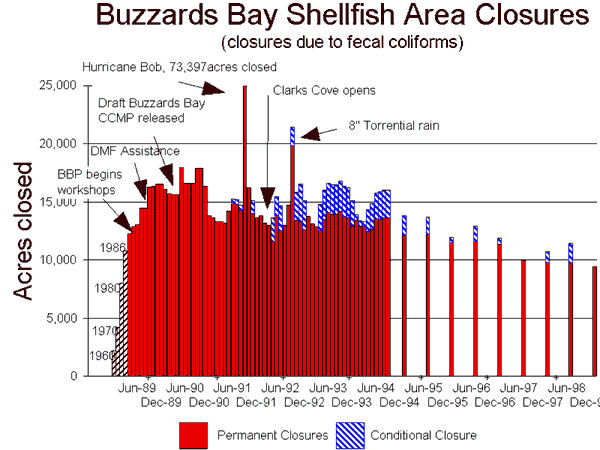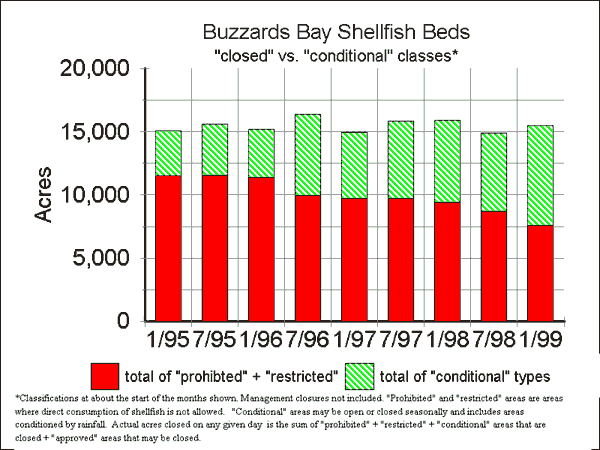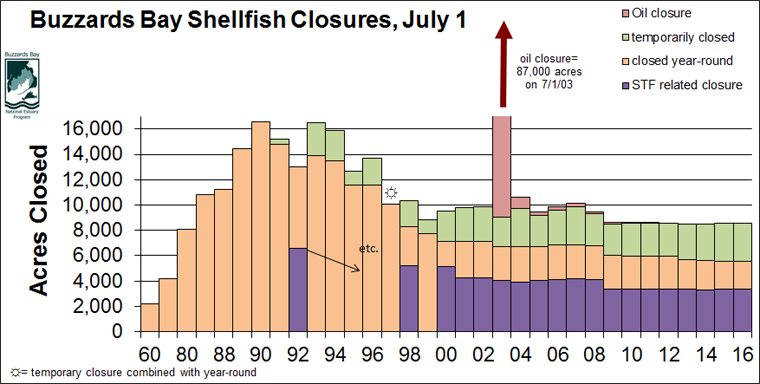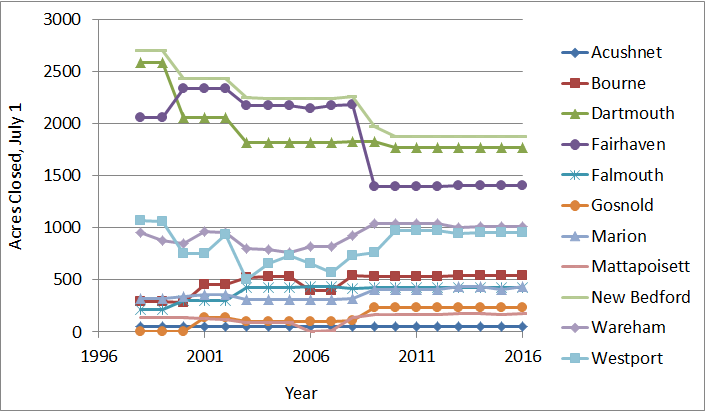Shellfish Bed Reopening Success Stories
Related Pages: B120 Shellfish Oil Spill Closures
Note: Much of the information on this page was based on data kindly provided by the Massachusetts Division of Marine Fisheries.
Turning the tide on shellfish bed closures in during the 1990s
Throughout the 60s, 70s, and 80s, shellfish beds were increasingly being closed in Buzzards Bay due to fecal coliform contamination. As a result, keeping shellfish beds open and reopening closed beds were among the highest priorities contained in the Buzzards Bay Comprehensive Conservation and Management Plan when it was drafted in 1990. As shown on the graph below, the situation has considerably improved.

While the Buzzards Bay NEP contributed in modest ways to this turn around, the real credit goes to the State Division of Marine Fisheries (DMF) and numerous municipal officials who have worked together to identify and remediate pollution sources. The opening of shellfish beds in Buzzards Bay resulted from two factors: water quality improvements and improvement capacity to undertake “conditional closure” programs.
The Buzzards Bay NEP’s own efforts began in 1989 with a series of Project workshops that brought together scientists, agency staff, municipal officials, and citizens to discuss the ever increasing shellfish bed closures in the Bay. The workshops were meant to both educate and to formulate recommendations for the Management Plan.
These early meetings made clear that the increasing shellfish bed closures in Buzzards Bay were not the result of the New Bedford or other municipal wastewater plant, but rather the result of cumulative impacts of local land uses. So called “non-point sources” of pollution like failing septic systems, stormwater discharges, farm animal wastes, agricultural sources, boat discharges, pets, and even waterfowl (especially where populations were encouraged by human feedings) were the more likely culprits. Of these sources, water quality monitoring had shown that in many embayments, stormwater was often the major conveyor and source of fecal coliforms causing these closures.
These findings prompted several important recommendations in the CCMP. First, towns should adopt the goal of allowing no further direct discharges to surface waters and wetlands. Second, those discharges contributing to shellfish closures should be prioritized for remediation. Finally, the Division of Marine Fisheries should work with area municipalities to allow “rainfall conditional openings”. That is, DMF should shellfish beds during dry periods, in areas where it has been demonstrated that fecal coliform concentrations are low enough so that shellfish are safe to consume.

The first challenge to keeping shellfish beds open in Buzzards Bay occurred in 1989 when new monitoring and sanitary survey requirements imposed by the US FDA could not be met by the DMF because of insufficient staff and laboratory capacity. In the face of potential widespread management closures of the bay, the Buzzards Bay NEP supported a DMF proposal to upgrade area laboratories to handle the additional water sampling needed. Specifically the project gave $35,000 in grants to the City of New Bedford and Barnstable County Health Department to upgrade their laboratories and to pay for the analysis of extra samples collected by DMF. To meet federally imposed deadlines, DMF staff also trained local officials to assist with the sanitary surveys in their communities.
The upgrade of area laboratories and the closer coordination between DMF and municipal officials were to have long-term benefits for Buzzards Bay. Most importantly, by 1991 DMF was able to begin implementing a rainfall conditional closure strategy for selected Buzzards Bay embayments (see the Clarks Cove and Westport River Shellfish Area Restoration stories).
After these early successes, the Massachusetts DMF and town Boards of Health continued to rigorously monitor and identify upstream pollution sources. Throughout the 1990s, Buzzards Bay municipalities continued to remediate stormwater discharges, many farmers implemented agricultural best management practices (BMPs), and homeowners replaced failed septic system with new septic systems, or tied into community or municipal wastewater systems. The hard work by Buzzards Bay communities have paid off and contributed to the decline in shellfish bed closures in Buzzards Bay shown below.
Trends in the 2000s
Since 2000, there have been more modest shellfish bed openings as a result of reductions bacterial pollution. In 2003, the Bouchard oil spill caused the closure of large portions of the bay for a few months, with some small closures continuing to 2009. The area of Buzzards Bay permanently closed to shellfish remained relatively constant until 1100 acres of shellfish resource areas were opened in August 2008. Since then the one remaining bright spot is that there has been a small steady decline of permanent closure areas being converted to seasonal or rainfall conditional closures.

The trends are not all positive
Most of the declines in permanently closed shellfish beds during the past 25 years have occurred in three towns: New Bedford, Dartmouth, and Fairhaven. These declines were the result of elimination of certain CSO discharges in New Bedford, expansion of sewering on Sconticut Neck in Fairhaven, and the treatment of stormwater discharges in Dartmouth and Fairhaven. In contrast to these positive trends, shellfish bed closures have increased Wareham, Bourne, and Gosnold. In Westport, the area of permanent closures declined during the 2000s, but rose again nearly to the levels of a decade earlier.
